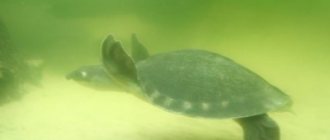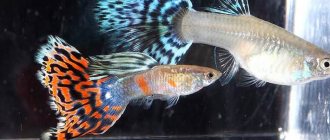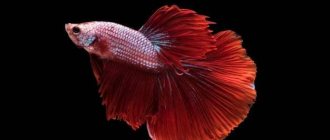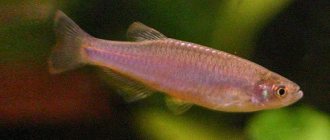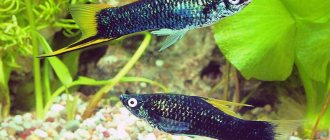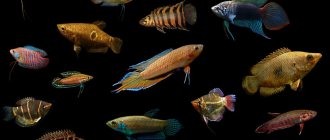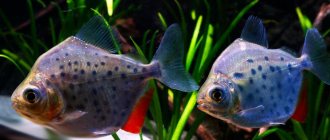It is very unpleasant when fish begin to die in an aquarium. It would seem that everything was done correctly: clean water was poured, the aquarium equipment was working, the fish received food in a timely manner. Despite this, living creatures die. Unfortunately, this situation occurs quite often among beginners in the aquarium business, which is why it is necessary to arm yourself with knowledge about the causes of this phenomenon.
Every novice aquarist should understand the following in advance: if conditions in a water house are created for its inhabitants as close as possible to their natural habitat, then they will not get sick, much less die.
At the very least, the risk of death will be minimized.
Practice shows that in the vast majority of cases, the death of fish is not caused by any external diseases, but by errors in maintenance, illiteracy and carelessness of their owners. There are various reasons for this unfortunate phenomenon or a whole combination of reasons and factors that should be considered in detail.
Nitrogen poisoning
Nitrogen poisoning is the most common problem. It often concerns beginners who have no experience in dealing with aquarium animals. The fact is that they try to feed their pets to their fullest, forgetting that at the same time the amount of waste increases. According to the simplest calculations, each fish leaves excrement equal to 1/3 of its weight per day. However, not everyone knows that in the process of oxidation and decomposition, nitrogen compounds appear, consisting of:
- Ammonium;
- Nitrates;
- Nitrites.
All these substances have in common their toxicity. The most dangerous of them is considered to be ammonium, an excess of which will be the main cause of death of all inhabitants of the reservoir. This happens most often in recently launched aquariums. It is the first week after the start that becomes critical. There are two options for increasing the amount of these substances in aqua:
- Increase in the number of residents;
- Filter failure;
- Excessive amount of feed.
You can determine the excess by the state of the water, more precisely by the smell and color. If you notice darkening of the water and a rotten smell, then the process of increasing ammonium in the water has begun. It happens that upon visual inspection, the water in the fish house is crystal clear, but the smell makes you wonder.
To confirm your suspicions, ask for special chemical tests at pet stores. With their help, you can easily measure the level of ammonium. True, it is worth noting the high cost of the tests, but for a novice aquarist they are very necessary if you do not want to lose all your pets in a couple of days. If the situation is corrected in time, a fatal outcome can be avoided.
How to lower ammonia levels:
- Daily ¼ water change
- The water must stand for at least a day;
- Checking the filter and filter element for serviceability.
Gas chamber
Man loves clean air. Living in the city, especially next to industrial enterprises, is not a pleasant experience. That is why people strive so much for nature. Fish live in water, which is the same “air” for them. The slightest changes for the worse instantly affect the well-being of pets.
Fish and other aquatic inhabitants, like all creatures on this planet, leave behind a lot of organic products. These include excrement, particles of epidermis, and leftover food. As a result, the water is saturated with organic decay products - nitrogenous compounds: ammonium, nitrates and nitrites. This trio is incredibly poisonous.
Lack of oxygen as a negative factor
Fish are known to breathe air dissolved in water, and they can suffocate if there is too little of it in the water. Although such cases are very rare, they do occur.
As a rule, even beginners first purchase all the equipment necessary to operate a home aqua system.
And very often, when buying a fairly powerful filter, they trust it not only with water purification, but also with its aeration and mixing.
Still, experts recommend separating these two functions and ensuring constant operation of the air compressor
Megapolis
It's never worse if the pool is overcrowded. Yes, the wild desire to stock all the fish you like is difficult to quell. But it’s enough to put yourself in the place of the unfortunate pets and everything will immediately become clear. In such “megacities” the main problem is the lack of oxygen. Simply put, the fish are dying because they can’t breathe. Increased aeration and dispersal will solve the problem. Signs of asphyxia: heavy breathing, the fish swims near the surface, opens its mouth wide, jumps out of the water.
Fish diseases
No one wants to blame themselves, so novice breeders blame illness for everything. Unscrupulous sellers only reinforce their doubts, since their goal is to sell expensive medicine and make money. However, do not rush for a panacea; carefully study all possible causes of death.
Diseases can only be blamed if the symptoms have been present for a long time. The fish faded away gradually, and did not just die in an instant, for no apparent reason. Most often, the disease is brought into the aquarium along with new residents or plants. Death can occur due to a malfunctioning heating element in cold weather.
When going to pet stores, you must be aware of what exactly you need medicine for. Each drug is aimed at a specific disease. There are no universal cures! If possible, consult with an experienced aquarist or on a forum; knowledgeable people will tell you what to do in such a situation.
Of course, disease cannot kill healthy fish. Why do fish die in an aquarium? If death occurs, it means that immunity has already been undermined. Most likely, the first two errors occurred. Do not rush to launch new residents, no matter how beautiful they are.
What to do to protect your aquarium:
- Organize quarantine for new residents;
- Sanitize your fish or plants.
What to do if there is a disease in the aquarium:
- Change a tenth of the water daily;
- Increase the temperature;
- Increase aeration;
- Remove disease carriers and those who are clearly infected.
Remember what kind of fish you launched at home last. Individuals brought from other countries can be carriers of rare diseases, which are sometimes not possible to detect and classify on their own.
Fishes are not launched correctly
When fish are purchased and transferred to a home aquarium, the hardness, acidity and temperature of the water change. And it’s a lot of stress for the fish to change their habitat. A sudden change in acidity, even in minimal quantities, leads to the death of sensitive fish. Improper settlement can be disastrous for all aquatic inhabitants.
In order for aquatic inhabitants to adapt to a new environment, it is necessary to follow the instructions:
- You should pour the water with the fish into a large tank;
- Add some water from the general aquarium;
- After 15 minutes, repeat the same action;
- Dilute the water to at least 70% solution.
If some fish survived due to improper adaptation, then, unfortunately, they will die with the first illness. Their immunity is undermined, so bacteria attack them first. There must be proper care, namely: monitoring aeration, cleanliness and new inhabitants.
O2 deficiency
This option is the rarest of all. The oxygen saturation of a fish house is always adequately assessed even by novice aquarists. The first thing everyone does is buy a compressor. With it there is no fear of fish suffocating.
The only possible option is an increase in temperature and, as a result, a decrease in oxygen in the water. This can happen at night, when plants switch from producing oxygen to absorbing it. To avoid this, do not turn off the compressor at night.
Diseases
The third and most important cause of death for aquarium pets is disease.
This includes:
- Diseases as a result of decreased immunity due to poor water, incorrect adaptation or improper diet. Before resorting to the use of any drugs, make sure that all causes have been eliminated.
- Diseases that could be carried by sick fish. You should be especially careful when handling imported fish. Before being placed in an aquarium, they must be examined for the presence of diseases and dangerous bacteria that can cause the death of other inhabitants of the aquatic world.
Aggressive neighbors
Before you go to the store for pets, think through to the smallest detail: will several species be able to get along in one fish house? You should not count on the seller’s competence, since his main goal is to sell as much product as possible.
A few fundamental rules:
- Big fish always try to eat small ones (even in the case of herbivorous species);
- Many succumb to intraspecific aggression;
- Some are able to attach themselves to small neighbors, which ultimately results in death;
- The strong always eat the weak;
- Buy only those fish that you are sure are peaceful.
Unfortunately, it is impossible to determine why the fish are dying. The death of a pet can happen even among experienced breeders. Treat your fish carefully, and you will definitely notice a change in behavior and eliminate the cause of concern in time. More often than not, fish die in an aquarium due to oversight, and not due to other criteria.
Water temperature
Another reason for the death of aquarium inhabitants is overheating or hypothermia of water. Monitoring the water temperature is difficult. If in the case of cold water a thermostat can still help, then cooling makes you suffer. Of course, those who simply cannot imagine life without an aquarium undoubtedly purchase cooling units, while other hobbyists try to do without it. As a result, in the summer the water in the home pool does not boil. An air conditioner or installing a home pond in a room where the sun shines either in the evening or early in the morning will help.
These reasons are the most common in the mass death of aquarium inhabitants. We need to start saving fish by solving these very problems. And, as a rule, the fish pestilence stops.
What to do if you find dead fish in the walls of the aquarium?
- Take a closer look at the number of fish in the tank. Count them in the morning and during feeding hours. What is their condition, are they getting food well? Are there any fish that refuse food? Is it possible for one of the fish to have bloating? If you do not find any fish, check all corners of the aquarium by lifting the lid. Inspect the plants, caves and all the decorations. If after a few days the dead fish has not floated to the surface, it may have been harmed by a neighbor in the aquarium, and you are unlikely to find it again. Sometimes fish get caught in an unprotected filter and die there. In any case, continue searching until you find visible reasons for the disappearance.
- Fish that have died in the aquarium must be removed from it. Tropical fish species quickly rot due to elevated water temperatures. In such an environment, bacteria multiply quickly, the water becomes cloudy, and an unpleasant odor appears, which can infect other pets.
- It is necessary to inspect the dead fish. You must understand why she died in the aquarium. Put medical gloves on your hands. If the body is not completely decomposed, look at the condition of the fins, scales, and the condition of the abdominal cavity. Perhaps there will be wounds on the body or signs that she suffered from unkind neighbors. If the belly is very swollen, the eyes are bulging, the scales are covered with plaque or spots, this means that the pet has suffered from illness or poisoning. After inspection, the gloves should be discarded.
- Check water parameters. Water is often the main cause of deterioration in fish health. Take tests with indicators and make the necessary measurements. The increased content of ammonia, nitrates, and heavy metals in the water leads to pets quickly dying. If the aquarium has a decorative element made of iron, zinc, or copper, this is another indicator. Some fish do not tolerate metal well and die suddenly.
- After the test results, draw conclusions. The test will show two results - either everything is fine in your aquarium, or the water is dirty and contains an excess of toxic substances. In the second case, you need to turn on powerful filtration and replace 25% of the aquarium water with clean and infused water. There is no need to change water parameters abruptly; this can harm living fish.
- But if the water is in good condition, there could be a number of other reasons why the fish died. Sometimes aquarium pets die from hunger, overeating, illness, severe stress, bruises received after being attacked by other fish, or age. If fish die suddenly, you need to do everything necessary to keep others alive. Contact your veterinarian if no obvious cause of your pet's death is found.
LIFESPAN OF AQUARIUM FISH.
PH IN THE AQUARIUM - PHOTO VIDEO DESCRIPTION REVIEW.
MUDDY WATER IN THE AQUARIUM: WHAT TO DO - DESCRIPTION OF THE PROBLEMS PHOTO VIDEO.
HOW, WHAT AND HOW MUCH TO FEED GOLDFISH? DESCRIPTION PHOTO VIDEO.
AQUARIUM FISH THAT CAN GET WITHOUT OXYGEN AND AIR
Fighting nitrogenous compounds
Suspicion of gas contamination should be caused by the smell emanating from the water. Outwardly, the water may look crystalline, but this is a deception. A good solution would be to use special tests to determine nitrogen compounds. But the first step is:
- Emergency evacuation. The fish must be transplanted into a container with clean water as soon as possible. If there is no settled water, then you need to use stabilization tablets, which can be purchased in specialized stores. A basin is used as a container if there is no other aquarium. It is necessary to ensure the same temperature as in the “native” reservoir and establish aeration.
- Turn on the aerator and filter at full power while preparing the fish tank. This event will saturate the water with oxygen and purify it during the first hours of help.
- Rinse the aquarium, siphon the soil, change the water completely or replace more than 50% with fresh water. A complete restart is not a good idea. Such events are carried out if the fish are already on the verge of death: they lie on the bottom, gasp for air, swim on their sides.
- Regular water changes are the key to the normal functioning of the aquarium. But this must be done correctly. In “young” reservoirs, in which the balance has not yet been established, water is changed to a minimum: 1/5 – 1/10. This is enough to avoid the “swamp” state.
- Add charcoal to the filter. You can buy it at any aquarium store. This is a real “ambulance” in the fight against waste from the inhabitants. An absorbent, for example, zeolite, is also used. It gets rid of nitrates and nitrites. As for the filter itself, it must match the volume of water.
Healthy golden
First, let's define how a healthy goldfish behaves. These hydrobionts lead an active lifestyle. Their movements are smooth and often leisurely, but movement is literally life for fish!
The color of the scales should not change; bright scales without any plaque are a healthy fish. Good appetite – always! These babies have such a voracious body that they can even die from overeating. Goldfish hardly feel full, so they are always eager to have a snack.
A healthy pet has a bright color, clear boundaries of the fins and tail. He is in good spirits and eating well.
Preventing deaths
The problem must be prevented before consequences occur. This will save the lives of aquarium pets . Prevention measures need to be taken:
- Carefully transport them from the store. In winter, you need to use thermoses.
- For new fish, you need to quarantine for 20-30 days (in aquarium water).
- Use different equipment for sick and healthy individuals.
- Change a quarter of the water three times a month.
- Overcrowding an aquarium is highly discouraged.
- Use species-specific food.
- Constant temperature control.
By following all the recommendations, you will be able to avoid most problems when keeping fish. If one of them dies, you need to immediately remove it from the aquarium.
Even people with extensive experience can have fish die. You need to be attentive to your aquatic pets , then you will be able to notice the problem in time.
Popular beliefs
According to historical data, the ancient Egyptians were engaged in fish breeding. Decorative fish are four thousand years old. And the first breeders were the inhabitants of ancient China. The famous art of Feng Shui devoted many pages to the rules of equipping the underwater kingdom in the apartment.
Folk signs about fish
From time immemorial, fish have been considered symbols of carelessness and tranquility. If there is an aquarium in the house, the energy of the home normalizes, becomes favorable and relaxing. The presence of aquarium goldfish promises strengthening family ties and attracting finances to the family.
In Chinese, the characters for “abundance” and “fish” are written in the same script.
Even the death of pets in an aquarium, according to the teachings of Feng Shui, is symbolic of the renewal of life. Underwater inhabitants, protecting the owner, take on his misfortunes, which is why they die, as followers of ancient Chinese teachings believe. In order for the fish aquarium to work 100%, consider the rules for its location in the apartment:
- To the left of the front door. Brings a charge of positive energy into the house.
- On the southeast side. Normalizes relationships between spouses and has a beneficial effect on health.
- On the north side of the house. Increases career success, career advancement and respect from colleagues.
It is not recommended to install aquariums in the bedroom, kitchen and in the south-eastern area of the apartment. To improve your financial well-being, buy a round, rectangular or square aquarium.
Speaking about the number of underwater pets, Feng Shui advises choosing a multiple number (the best option is three individuals). Among them there must be a black fish to ward off misfortunes. To provide your family with comfort, harmony and protection from betrayal, get 9 pets (red and silver).
If the fish die, replace them with new ones and clean not only the aquarium, but also the apartment/house.
Proper aquarium care - disinfection
Do not forget that an aquarium is a real home for fish. It, like a human home, needs cleaning. If a person can provide himself with frequent cleaning, then such a luxury is not available for fish, so it is the owner who must disinfect the aquarium and monitor the condition of his pets. Many people know about this, but not everyone knows how to disinfect an aquarium correctly.
Primary activities
The first disinfection of the aquarium occurs immediately after you purchase the tank. The future house for fish must undergo careful processing before the first inhabitants of flora and fauna appear there.
How to properly carry out primary disinfection:
- Fill the aquarium with plain water.
- Dilute the potassium permanganate solution to a dark color and pour it into an aquarium filled with tap water.
- After this, leave it for a day. During this time, all pathogenic bacteria will die.
- Drain off all the water and wipe the walls dry with a dry cloth.
- Rinse it several times with clean running water.
The next step will be preparing the water to start a new aquarium. In order for free chlorine to leave the water, it is necessary to leave 100% of the water for at least 3 days. Then pour it in and wait a couple of days again. Only after this will the aqua be ready to accept its first inhabitants.
In order not to waste time, prepare the rest of the equipment and decor for your exclusive pond.
Don’t forget, they also need to be thoroughly disinfected before they end up in the same water as fish. Particular attention is paid to the soil. It is most often used sea sand and pebbles collected in natural conditions. Of course, the substrate contains a huge variety of pathogenic bacteria that will poison the entire environment in the water. To overcome the negative consequences, you need to calcine the soil in the oven or in a large frying pan. It is necessary to expose the entire soil to maximum temperature for at least 20 minutes. For convenience, divide it into portions. Do not pour hot sand into the aquarium! Cool and rinse it thoroughly.
One wash is not enough, it is better to repeat the procedure 3-4 times, only after that you can place it in the aquarium. You should not ignore this stage of the initial start-up of the aquarium. Accessories are considered among the mandatory elements of the normal functioning of an artificial reservoir. Collect all decorative elements, excluding plastic options, and boil them thoroughly. Since heat treatment can cause plastic parts to melt, it is better to treat them with a dark solution of potassium permanganate.
On-line disinfection measures
If the aquarium is already functioning, but something bad happened and various bacteria and algae began to appear in it, then disinfection cannot be avoided. It is urgent to save plants and fish from there.
All fauna that was in the infected aquarium must be treated with an antibacterial solution. The most popular is a mixture of 10 mg penatsillin per 2 liters of water. Keep the plants in it for about 3 days. Don’t be afraid, nothing bad will happen to the plants during this time. The aquarium itself can be disinfected with a special bactericidal lamp every day for 20 minutes. Disinfection of the aquarium is necessary even if there are no visible problems. Preventative measures are the best way to maintain the health of fish and other inhabitants. The next disinfection begins with disinfecting treatment of all surfaces. The simplest means at hand are potassium permanganate and peroxide. Remove all the fish and decor from there, then fill it to the edge with 3% peroxide or a dark solution of potassium permanganate. Leave everything for 5-6 hours. After this, thoroughly rinse all surfaces and corners.
If you have neither the time nor the desire to wait that long, then you can use the express method. Buy a special solution at the pet store that is designed to disinfect all surfaces. Don't forget to wear gloves before working. If you have the opportunity to treat everything with formaldehyde, chloramine, hydrochloric acid, then use this option.
To disinfect plants, it is necessary to prepare a penicillin solution in a ratio of 10:2. Leave all the plants there for about three days.
The most common means:
- Isopropane 70%;
- Ethanol 70%;
- Sidex;
- N-propanol 60%.
You can wipe the plants with these products just once; this will be enough to kill the pathogenic sphere. These products are sold in pet pharmacies. The rest of the equipment should be boiled. To be sure, keep them in boiling water for at least 20 minutes. The more time they spend in boiling water, the less chance the bacteria have to survive. Please note that rubber, plastic and thermometers should never be boiled.
Choose the most convenient method for yourself and enjoy the view of a beautiful, healthy aquarium with happy fish.
aquariumax.ru>
